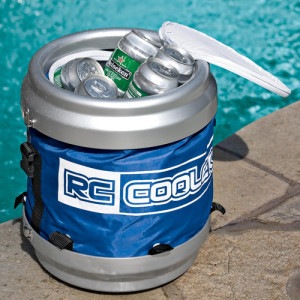Literally. Like in a thermos. Like what it takes to have any hope of having a cool drink on a hot day at the beach. Let me explain.
It’s been a hot July. Day after day in the high 80’s and 90’s with only the briefest relief. 
Most folks respond by turning on the AC. It’s the “EASY” button for comfort in this heat.
No AC? Folks are calling our very busy HVAC contractor to see about installing a system in a house without one. That or getting the one that is installed to actually work. Too expensive? Then it’s a trip to the hundreds of stores advertising (inefficient)window units at cheap prices in the paper every cooling season. Or hauling out the units that have been stowed away since last summer.
But as author Stan Cox points out in his recent history of air conditioning “Losing Our Cool”, pushing this EASY button has consequences. The vast amount of energy required to run these systems is largely generated by fuels that are contributing to the very warming they are equipping us to endure.
It’s not that what we want is air conditioning. What we’re after is comfort. And comfort generally means relief from the oppressive heat and humidity. How much relief? Comfort certainly means different things to different people depending on their individual metabolic rates, activity level, and clothing as well as the temperature, humidity, and air movement in their environment. Can we control some of these to produce comfort without using so much precious energy? Absolutely.
First, when it’s this hot outside we’re hoping for a difference when we come indoors. And feeling a difference is the first step toward comfort. So what we are after is a difference between outdoors and in. How big a difference? That depends.
Some people demand refrigerator like levels of cool in the low 70’s. Others, conscious of the spike in their electric bills and as comfortable with it a few degrees warmer follow the common guidance of a setting at 78. Now here is where it gets interesting.
While the average high temperature for July is 85, the average low is 64. So nearly every 24 hours the nighttime cool is considerably lower than what we find comfortable when it is hot. If we can invite this cool nighttime air in, and then keep the daytime heat from warming that indoor air, we might not need to use energy to keep our cool!
There is nothing new about this idea. It has been practiced around the world in climates considerably more severe than ours. Prevent cool air from being warmed. Replace warm air with cool air when it is available.
Now back to the thermos. One of the most effective ways to do this is to construct a building that dramatically inhibits the ability of heat to be transferred from outside to inside (and vice versa in the winter for comfort then). The Passive House method is the gold standard in achieving this quality of building performance. Every method of heat transfer – conduction, convection, and radiation – is deliberately and rigorously controlled. Like a thermos keeping our drinks cold on a hot day, once an interior level of comfort is established, it is very slow to change, no matter the harshness of the temperature outside – summer OR winter.
But even in a home that is not constructed to the exacting standards of a Passive House, inviting cool night-time air in and then keeping it there as the daytime temperature rises by closing and shading the windows can create a difference between inside and out that will be experienced as comfortable. Try it and see for yourself. In our arsenal of strategies to use energy responsibly, this one deserves your consideration.
Use less. Save more. Live comfortably.
For more on strategies to “keeping your cool” without excessive use of precious energy, visit this exceedingly practical advice for Simple Strategies for Keeping Cool from Alex Wilson at Building Green.
